

Registered Charity No 1075342

Reviews of Meeting Points Presentations
January 2013 -
Reviews by Jacqueline Sims
Meeting photos: Anthony Smith
(Unless otherwise shown)
(Unless otherwise shown)
Radley Gotch
Customs & Excise
February 2013 Meeting

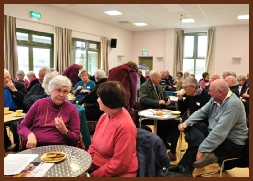
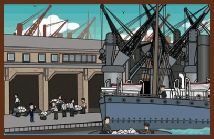
On the basis of a very long career with HM Customs and Excise, including in Poole, Radley entertained us with a combination of hard facts and hilarious anecdotes on the fate of those wishing to short-circuit the attentions of the customs, in both past and present times.
Underlining that the Customs Service is, in fact, closer to the police than the civil service, Radley indicated that Customs is entitled to carry out searches without a warrant, must
receive assistance from the armed forces on demand, may stop and board boats at any time to check their cargoes, or may give chase in “Hot Pursuit” beyond national waters under the provisions of the International Law of the Sea.
There are a wide range of complex arrangements governing the arrival of goods into the country by air or sea, their declaration and inspection, the allocation of appropriate tariffs, the issuing of licenses, the confiscation of unpermitted or smuggled items, and the levying of fines. This requires completion of reams of
paperwork, and keeping one step ahead of the lawbreakers in identifying ever more cunning pilferers, and ever more inventive hiding places! One enterprising tobacco smuggler even made the mistake of attempting to flog his ill-gotten gains to Radley himself!
These are not the only hazards, however. On various occasions throughout his long career, Radley has had to deal with personal threats from those whose lucrative perks from
scams and rackets were cut unexpectedly short by his discovery of them, and in some instances they did not wish to go quietly! And in today’s more deregulated world, large-scale, highly-organized smuggling rackets are becoming more common.
Should Purbeck U3A plan to continue a great Dorset tradition and establish a new Smuggling Group, we have all the necessary information in our hands to ensure we escape detection!



Howard & Sylvia
Oliver
A Tale of Peter Rabbit, Moths and Mushrooms
January 2013 Meeting
Review by
Theresa Cook
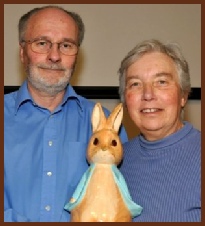
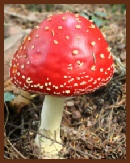
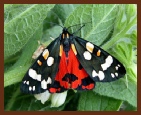
Dr Oliver gave a well-paced lecture, packed with relevant information and illustrations, followed by Sylvia with a selection of quality photographs of moths and mushrooms taken with a basic digital camera.
Beatrix Potter was portrayed with a great deal of respect. Like many women of that era, she was not taken seriously during her lifetime. Well done to Kew for apologising for the way she was treated. Her books and illustrations are so precious and hark back to a time of innocent childhood and simple pleasures we are now losing due to the all pervading march of technology.
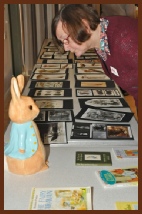

Jean Gibbs
Antiques Hallshow
Focus on British Glass
March 2013 Meeting
Meeting photos: John Hale
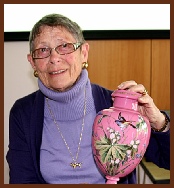
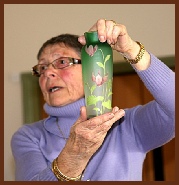
Introduced early to glass and antiques by her jeweller/watchmaker father, Jean demonstrated a wealth of knowledge on past and present glassmaking in Britain, drawing on a lifetime of experience and items from her own extensive collection.
Glass has been around for a very long time, first made around 4,000 years ago through the technique of pressing and moulding. The Romans discovered glass-blowing, and during their occupation of England set up a large glass manufacturing site in Gateshead. Very old pieces of glass can occasionally still be found in places such as Kimmeridge and Swanage.
Glass moved into a new dimension with the creation of patents for Venetian glass in the 16th century, which produced luxury goods for the rich. During the 17th century, lead was added to the glass-making process for the first time, to facilitate greater demand. At this time windows were first made, and decorative enamelling on glass became the fashion.
The Industrial Revolution sparked significant changes in money spending, along with higher standards in home decoration. Chandeliers became a common requirement as the middle
class became cash-richer, and this period also saw high demand for styles such as “cameo” glass where a second layer was applied, then cut away into various designs. Decorated glass was a late Victorian “must have,” and while it may not meet today’s taste, the skill and technique involved is undeniable with up to three glass layers superimposed and carved. Decorating glass, in fact, formed part of any well-brought-up young lady’s training!
Purbeck U3A members may contact Jean to see her collection by clicking HERE
The first industrial glass design and production appeared in the late 19th and early 20th centuries with artists like Christopher Dresser. Tiffany’s was also establishing itself at this time, offering new approaches to glassware. Satin glass, “cloud” glass, and “slag” glass were all popular, offering different textures and colours. The famed Irish Waterford glass of southern Ireland began production as early as 1783, and has undergone a number of stops and starts since then. Unfortunately, it is now only produced abroad.
The two World Wars brought a great deal of glass production to a halt, and since then production in England has become rare, restricted mainly to small artisanal businesses producing fine work, but on a limited scale.
Jean then examined a number of interesting pieces brought to the meeting by U3A members, and in most cases was able to add to the owners’ knowledge about their treasures! She also referred throughout the talk to various places, museums and websites that can be visited by those interested in extending their knowledge. Anyone wanting advice in this direction is welcome to get in touch with Jean.

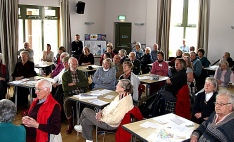
Mouse over photo to enlarge

Just to thank everyone at my talk for their generosity -
